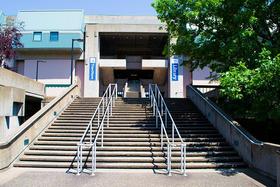- College of Eastern Utah is committed to the highest standards of instruction and learning in its academic and applied technology programs. The College prepares students for certification, degree or transfer programs and recognizes that education continues beyond graduation. We strive to help instill the curiosity and skills necessary for a student to continue learning throughout life.
School Highlights
Utah State University-College Of Eastern Utah serves 2,323 students (55% of students are full-time).
The college's student-teacher ratio of 15:1 is lower than the state community college average of 16:1.
Minority enrollment is 39% of the student body (majority American), which is more than the state average of 29%.
Quick Facts (2025-26)
- Enrollment: 2,323 students
- Student-teacher ratio: 15:1
- Minority enrollment: 39%
- Source: Integrated Postsecondary Education Data System (IPEDS)
School Overview
The teacher population of 154 teachers has stayed relatively flat over five years.
Utah State University-College Of Eastern Utah
(UT) Community College Avg.
Carnegie Classification
Associate of Arts Colleges
Not applicable, not in Carnegie universe (not accredited or nondegree-granting)
Institution Level
Less than 2 yrs
Four or more years
Institution Control
Public
Public
Colors
White, Aggie Blue, Grey
Total Faculty
154 staff
215 staff
School Calendar
Student Body
The student population of Utah State University-College Of Eastern Utah has stayed relatively flat over five years.
The student-teacher ratio of 15:1 has stayed the same over five years.
The Utah State University-College Of Eastern Utah diversity score of 0.58 is more than the state average of 0.47. The school's diversity has stayed relatively flat over five years.
Total Enrollment
2,323 students
4,285 students
Student-Teacher Ratio
15:1
16:1
# Full-Time Students
1,279 students
891 students
# Part-Time Students
1,044 students
3,394 students
# Enrollment Undergraduate
n/a
367 students
# Full-Time Undergraduate Students
2,323 students
891 students
# Full-Time Graduate Students
n/a
133 students
# Part-Time Undergraduate Students
n/a
3,394 students
# Part-Time Graduate Students
n/a
563 students
Total Dormitory Capacity
n/a
750 students
% American Indian/Alaskan
20%
1%
% Asian
1%
2%
% Hispanic
5%
13%
% Black
1%
1%
% White
61%
71%
% Hawaiian
n/a
1%
% Two or more races
1%
3%
% Non Resident races
2%
4%
% Unknown races
9%
4%
Diversity Score
0.58
0.47
College Completion Rate (Students who graduate in less than 4 years)
32%
33%
College Completion Rate (Students who graduate in 4 years or more than 4 years)
n/a
47%
Average Graduate Earnings (10 Years)
$34,000
$33,800
Tuition and Acceptance Rate
% Students Receiving Some Financial Aid
50%
70%
Median Debt for Graduates
$4,500
$15,306
Median Debt for Dropouts
$3,500
$4,750
Acceptance Rate
n/a
93%
SAT Reading
n/a
545
SAT Math
n/a
550
ACT Composite
n/a
23
ACT English
n/a
24
ACT Math
n/a
23
Source: 2023 (or latest year available) Integrated Postsecondary Education Data System (IPEDS) , School Administrators
School Notes
- School Mascot: Golden Eagle
- College of Eastern Utah is a two year, state supported community college operated under the Utah State Board of Regents. It is accredited by the Northwest Association of Schools and Colleges, by the Utah State Board of Education and is a member of the National Commission on Accrediting. Credits earned at the College of Eastern Utah are transferable to other institutions of higher learning in the United States. At Utah's youngest community college, numerous changes have occurred over the last 67 years. Since 1937 we have grown from Carbon College, with an enrollment of 146, to College of Eastern Utah, with an enrollment of over 3200 students. In the early years by an act of the Utah State legislature we were under the Utah State Board of Education. In 1959, the college became a branch of the University of Utah. In 1965 we became College of Eastern Utah, and four years later our relationship with the University of Utah was terminated. As a result of the 1969 Higher Education Act, we became a full-fledged member of the Utah State System of Higher Education. Our primary campuses are located in Price and Blanding, with a college center in Castle Dale. The Price campus has over 16 buildings. The campus settings are extraordinary. The opportunities for biking, hiking, fishing, and other outdoor activities is unparalleled. Because of our setting, our faculty and students have a chance to participate in world-class archeological and paleontological excavations. The college offer academic programs that facilitate seamless transitions to four-year institutions as well as applied technology programs that provide certificates and degrees that lead to jobs. The college Offers more than 400 courses in 60 areas of study, Associate of Arts & Associate of Science Degrees, Associate of Applied Science Degrees, Certificates of Completion and Great transfer programs to four year colleges & universities.
Recent Articles

The Rise of Technical and Vocational Training in 2025
Explore the 2025 surge in technical and vocational training—enrollment, policy, costs, and why this path is gaining ground for students and parents.

Stackable Credentials: How Community Colleges Advance Careers
Discover how community colleges use stackable credentials to build career pathways, boost earnings, and enable lifelong learning in 2025.

High-Paying Jobs You Can Get with a Community College Degree
Discover top high-paying careers you can launch in 2025 with a community college (associate) degree and high-growth credentials in tech, healthcare and trades.








